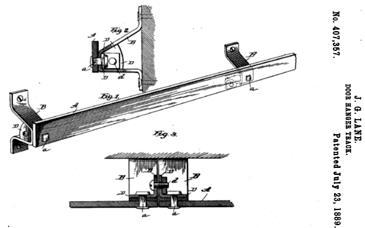
A fire had damaged, but did not destroy, a handsome Victorian home in Ohio. One particular interior wall, and the 4' wide pocket door housed therein, suffered mortal damage. The contractor was referred to me from a New York website dealing in old house hardware. http://www.wmjrigby.com The contractor's office manager said that in the early stages of clean up from the fire the demolition crew had apparently tossed out the Lane (brand) pocket door hangers, the top door plates and the entire metal track. It was appropriate to discard the destroyed door, but they should have saved the metal accessories.
Without dwelling on the lamentable mistake, he continued, "There is a twin pocket door which survived the fire. Our job, in part, is to rebuild the partition to its former state-complete with a new door from a millwork company-but we need someone to provide the track and door hangers. Can you help us?" To the right is the photo of the surviving (twin) door. This door is 4' wide, 7' 6" tall and a whopping 2 7/8" thick!
The Lane Brothers Co. originally furnished track in sections-and that is what I have recreated here (two 5' lengths). The track (from both 1889 and 2009) is an 11/64" thick metal bar-a little under 3/16". The hanger wheels are sized to roll on this thickness bar.
I photographed the track at night-the standoffs show clearly against the shadow from the flash. For the purpose of these photos, the "feet" of the standoffs are clamped to a steel construction stud (similar to a 2 x 4) set on edge.
Lane Co. standoffs were from 7/64" bar and were riveted to the track. My standoffs are 11/64"-almost twice as thick-and are welded to the track. Why did I go to the bother of using thicker steel in 2009? Because the burnt 19th Cent.door was made from choice veneer over a substrate of pine. The replacement will be solid oak!-and will weigh a ton; that's hyperbole. Scarcely a door company today can take time to match the methods of the 1890's.
Also shown are two original Lane hangers from my inventory. The contractor has received two 5' lengths of track, two door hangers with adjustment screws & two door top plates. Shown on the right are some of the standoffs prior to being welded to the track (bars).
Major fabrication effort- making new parts and shipping them to a contractor
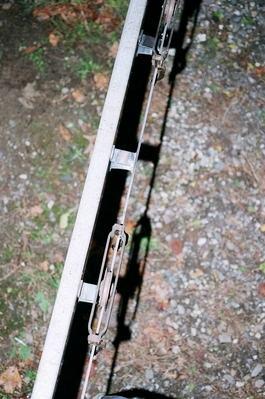
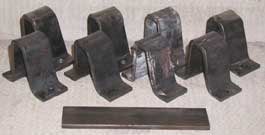
Here is a line drawing (or "cutaway" ) of a typical installation utilizing metal bar track. Please note that the hangers illustrated are not like the ones in the Ohio house. Look closely at the drawing and you will see how the track brackets or standoffs are attached to a board which is set on edge and fastened to the walls studs. The patent holders claim that the use of a metal bar set on edge is superior to the old method of using two parallel hardwood tracks.
In the photo to the left is a typical Lane track assembly. The view is looking upwards inside the tight confines of a pocket. The steel bar on edge is suspended by standoffs/brackets. The feet of the standoffs are anchored to a board running parallel to the track. Screws, driven horizontally through the feet of the standoffs, are the means by which this cantilever method relies. This arrangement, implemented by Lane Brothers and imitated by Richards Wilcox (and others), can support very big doors. However, if the track board might end up warping, or if the track board starts leaning away from the stud wall and starts shifting within the pocket, the door's free travel is going to be affected. This photo is from another location, not Ohio.
This patent drawing from July 23, 1889 shows the arrangement. Once attached to a board, the whole assembly is remarkably rigid.
For two of these photos, the "feet" of the standoffs are clamped to a steel construction stud (similar to a 2 x 4) set on edge.
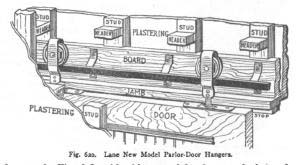
Here are two advertisements which show the progression allowed by new technology. The Lane hangers in my photos were touted as being "anti-friction" i.e. before ball bearings. I sent (to the contractor in Ohio) two of my Lane hangers as depicted in the left advertisement. Notice the horizontal slots in the hanger's frame. The axle of the wheels rotate and travel back and forth in the slots as the door moves. In the ad on the right, you will notice that the width of the hanger frame is less than in the anti-friction (earlier) model. The ball bearings, which of course are not visible, allow for the manufacturer to eliminate the anti-friction slot.
Before ending this discussion, I call your attention to the manufacturer's use of leather for soundproofing. The wheels were obviously a sandwich of two stamped metal discs with several thicknesses of leather-the whole assembly being riveted together. Pretty neat, huh?
SUMMARY---Metal tracks, made from stout bars set on edge, were only one of several methods for supporting top hung parlor doors. Sheet metal channels enclosing trolley type hangers were in use around the turn of the century (the other century!). Earlier still...overhead, parallel wooden tracks provided the bearing surface for a genus of pocket door hangers using 4" (and in some cases, 3") cast iron wheels.
For additional information, see Illustrated Field Guide to Pocket Door Mechanisms.
See Treating by Mail for a complete set of photos, and my diagnosis of this problem regarding a pair of doors suspended with Lane hangers.

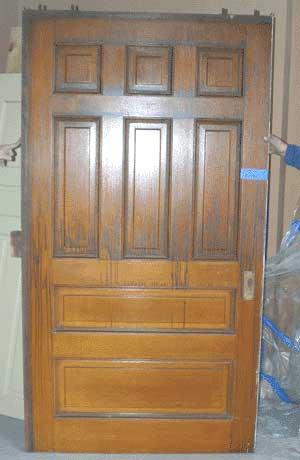
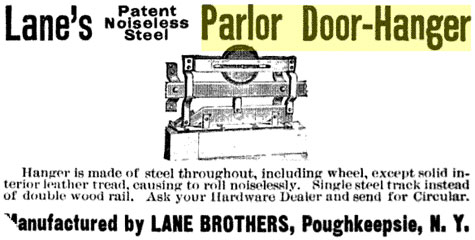
But there is an inherent weakness. If the board warps over time or if the installer's nails begin to loosen, then this "track carrying board" (on edge) can begin to lean over from the weight of the doors. Imagine a sailboat or a canoe beginning to tip over to one side. The clearances in a wall pocket are quite limited. The pocket door, whether a pair of doors or a single door, will begin to bind or scrape if the track carrying board should begin to cant over to one side.



























